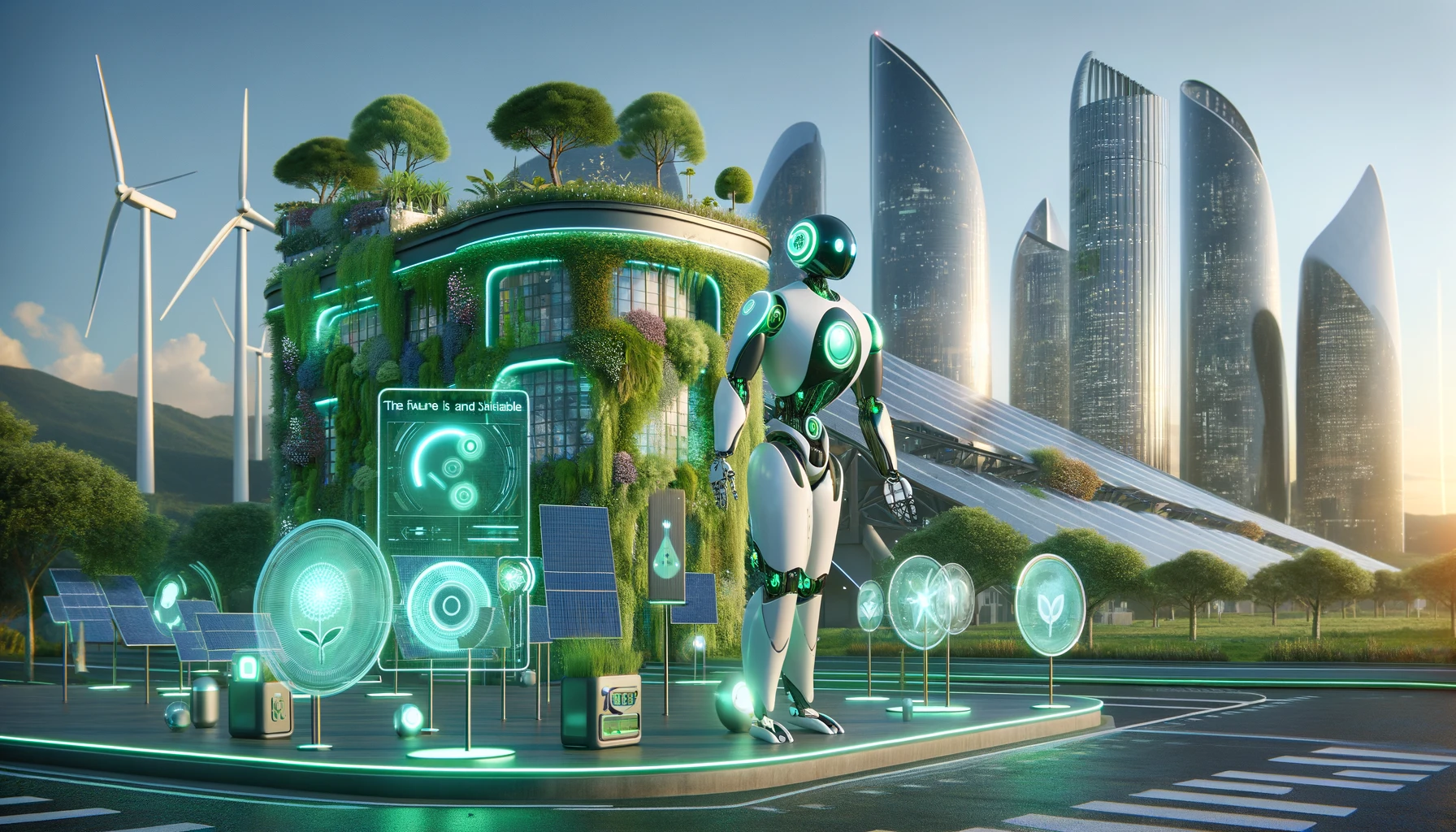Technology is a double-edged sword. While it’s revolutionized our lives, its environmental impact is a growing concern. But there’s a solution: Green Artificial Intelligence (Green AI). Green Artificial Intelligence leverages the power of AI for environmental sustainability. Let’s unpack this innovative concept and see why it matters.
Table of Contents
Green Artificial Intelligence: What It Is and Why We Need It
Green Artificial Intelligence is about developing and using AI in an environmentally conscious way. Imagine AI systems that minimize their carbon footprint while maximizing their positive impact on the planet. Sounds pretty good, right?
Here’s the thing: traditional AI systems can be energy guzzlers. They require significant computing power, which often translates to high energy consumption. Green Artificial Intelligence tackles this challenge head-on by promoting sustainable practices in the tech world.
Green AI isn’t just a fad; it’s a necessity. As AI continues to evolve, we need to ensure it doesn’t come at the expense of our environment. Green AI paves the way for a future where tech and sustainability go hand-in-hand.
The Intersection of Green AI and a Sustainable Future: Where AI Meets Green
Green Artificial Intelligence isn’t some distant dream. It’s already making waves in the realm of environmental sustainability. Here are two key areas where AI is playing a starring role:
AI’s Role in Energy Efficiency
Imagine buildings, factories, and power grids that automatically optimize energy consumption. That’s the power of Green Artificial Intelligence. AI algorithms can analyze energy usage patterns and adjust settings in real-time. Think automatically lowering heating when a room is empty or shifting to renewable energy sources during peak sunshine hours. Green Artificial Intelligence is like a smart thermostat for our entire planet!
Predictive Analysis in Resource Conservation
Environmental threats like wildfires or floods can cause massive damage. Green Artificial Intelligence is a game-changer here. By analyzing vast amounts of data, AI can predict these threats with greater accuracy. This allows for proactive measures such as targeted resource allocation for prevention or early intervention to minimize damage. Green Artificial Intelligence is like a fortune teller for Mother Nature, helping us conserve precious resources and protect our planet.
Powering Up Green AI: Innovations for a Sustainable Future
We’ve explored how Green AI leverages AI for environmental sustainability. But how do we make AI itself energy-efficient? Buckle up and dive into the world of Green Artificial Intelligence innovations!
Brainpower on a Diet: Breakthroughs in Low-Power Neural Networks
Neural networks, the core of many AI systems, can be power guzzlers. Green AI is revolutionizing this with low-power neural networks. Here’s the exciting news:
Reduced Complexity:
Researchers are designing neural networks with fewer connections and more streamlined architectures. This translates to less energy required for calculations. Imagine an AI that gets the job done with a smaller, more efficient brain.
Hardware Advancements:
Specialized hardware is being developed specifically for low-power AI applications. Imagine AI chips that are energy-efficient by design. This allows us to run powerful AI models without breaking the bank (or the planet).
These breakthroughs pave the way for powerful AI that doesn’t cost the Earth.
Sharper Algorithms, Smaller Footprint: Advances in Algorithmic Efficiency
AI algorithms are getting smarter and more efficient. Here’s how this benefits Green Artificial Intelligence:
Pruning Techniques
Researchers are developing methods to remove unnecessary parts of algorithms, making them leaner and more energy-efficient. Imagine trimming the fat from an algorithm without affecting its performance.
Quantization
AI algorithms can be converted to use less precise calculations. This might sound scary, but it often leads to minimal accuracy loss with a significant energy reduction. Imagine an AI that can still get the job done using less power.
Greener Grids, Smarter Sources: AI in Renewable Energy Management
Green Artificial Intelligence isn’t just about making AI more eco-friendly. It’s also about using AI to revolutionize renewable energy. Here’s how:
AI in Renewable Energy Management
Renewable energy sources like solar and wind are variable. The sun doesn’t always shine, and the wind doesn’t always blow. Green AI can optimize renewable energy grids by:
Predicting energy generation:

AI algorithms can analyze weather patterns and historical data to forecast solar and wind energy output. This allows for better integration of renewables into the grid.
Smart grid management:
AI can automatically adjust energy distribution based on real-time demand and supply. Imagine a grid that seamlessly switches between renewable sources and traditional sources as needed.
AI for Predictive Maintenance in Renewable Sources
Downtime for renewable energy sources like wind turbines can be costly. Green Artificial Intelligence can predict potential maintenance issues before they occur. This allows for proactive repairs, minimizing downtime, and maximizing energy production. Imagine a wind turbine that can tell you when it needs a tune-up, preventing a breakdown and keeping the green energy flowing.
Greener Than You Think? The Carbon Footprint of AI
Green Artificial Intelligence sounds great, but is it all sunshine and roses? The truth is, AI systems still have a carbon footprint. Let’s take a clear-eyed look at the environmental impact of AI and explore ways to minimize it:
Measuring the Impact
Calculating the carbon footprint of AI can be tricky**. It depends on factors like the hardware used, the amount of data processed, and the energy source powering the system. Researchers are developing better methods to measure AI’s environmental impact.
Strategies for Reducing AI’s Carbon Footprint
Even though measuring AI’s carbon footprint can be challenging, there are steps we can take to reduce it:
Use Cloud Providers with Renewable Energy:
Cloud computing is essential for many AI applications. Choose cloud providers that utilize renewable energy sources. Look for companies that are transparent about their environmental commitments.
Optimize AI Models:
Large AI models can be energy-hungry. Researchers are developing techniques to make AI models smaller and more efficient while maintaining accuracy. This translates to lower energy consumption.
Green Hardware and Software:
Hardware manufacturers are developing energy-efficient chips specifically designed for AI applications. Additionally, software companies are creating Green AI frameworks that optimize resource usage.
Green AI in Action: Real-World Examples Saving the Planet

Green Artificial Intelligence isn’t just theoretical. It’s making a real difference around the world. Let’s dive into some inspiring case studies showcasing AI for green solutions:
AI in Agriculture: Seeding a Sustainable Future
Agriculture has a significant environmental impact. Green Artificial Intelligence is helping:
- Optimize crop yields with AI-powered weather forecasting and disease prediction. This reduces water usage and pesticide application.
- Robots powered by AI can weed fields with precision, minimizing herbicide use.
- AI can analyze satellite imagery to monitor soil health and recommend optimal planting practices.
Imagine farms that are more productive and less harmful to the environment – that’s the power of Green Artificial Intelligence in agriculture.
Wildlife Conservation Through AI Technologies
Protecting endangered species is crucial for our planet’s health. Green Artificial Intelligence is a powerful tool for conservation:
- AI-powered camera traps can automatically identify animals and track their movements. This allows conservationists to target their efforts more effectively.
- AI algorithms can analyze aerial imagery to detect illegal deforestation or poaching activity. This enables faster intervention to protect wildlife habitats.
Green AI: Progress, But Not Without Challenges
Green Artificial Intelligence holds immense promise for a sustainable future. However, navigating this exciting new frontier requires careful consideration of ethical and policy issues. Here’s a breakdown of the key challenges:
Regulatory Frameworks for Sustainability
Green Artificial Intelligence is a rapidly evolving field. Developing regulations that encourage innovation while ensuring environmental benefits can be tricky. We need frameworks that:
- Define clear standards for measuring the environmental impact of AI systems.
- Incentivize the development and deployment of Green AI solutions.
- Promote collaboration between governments, tech companies, and environmental organizations.
Ethical Implications of AI in Environmental Decisions
- AI algorithms learn from data. Biased data can lead to biased AI decisions. Environmental policy is no exception. We need to ensure that Green AI is used in a way that is:
- Fair and equitable: AI systems shouldn’t disadvantage certain communities or ecosystems.
- Transparent and accountable: Decisions made by AI should be understandable and open to scrutiny.
Green AI: Going Green Makes Good Business Sense
Green AI isn’t just about environmental do-goodery; it’s a smart business decision. Here’s why industry adoption of Green AI practices is on the rise:
Corporate Responsibility in AI
Consumers are increasingly environmentally conscious. Companies that embrace Green AI demonstrate their commitment to sustainability. This can lead to improved brand reputation and customer loyalty.
Green AI Saves Money
Energy-efficient AI systems mean lower operating costs. Additionally, Green AI can optimize processes and reduce waste, leading to further cost savings. Imagine cutting energy bills while improving efficiency – that’s the win-win of Green AI.
Green AI isn’t just for big tech companies. Small and Medium Enterprises (SMEs) can also benefit:
Cloud-Based Green AI Solutions
Cloud computing provides SMEs with access to powerful Green AI tools without the need for expensive in-house infrastructure.
Focus on Specific Needs
SMEs can target Green AI solutions that address their specific needs. Imagine a small farm using AI to optimize irrigation or a local business using AI to reduce energy consumption.
The Future of Green AI: A Sustainable Tomorrow Beckons
Green AI is a rapidly evolving field with immense potential to revolutionize how we care for our planet. Here’s a glimpse into the exciting future of sustainable AI:
Upcoming Trends in Sustainable AI
Keep an eye on these emerging areas:
- Green AI Hardware: Chip manufacturers are racing to develop even more energy-efficient AI hardware. Imagine AI chips that are super powerful yet use minimal energy.
- Explainable AI (XAI): XAI techniques will make AI decision-making more transparent. This is crucial for ensuring fairness and accountability in environmental applications of AI.
- Green AI for Climate Action: Expect to see AI being used for more sophisticated climate modeling and developing strategies to combat climate change.
Research Gaps and Opportunities
There’s still much to explore in Green AI. Here are some key areas for future research:
- Standardization of Green AI Practices: We need common metrics for measuring the environmental impact of AI systems. This will allow for better comparison and development of effective Green AI solutions.
- Life Cycle Assessment of AI Systems: AI systems have an environmental footprint throughout their entire lifecycle, from manufacturing to disposal. Research is needed to minimize the impact at all stages.
- Democratizing Green AI: Green AI solutions shouldn’t be limited to tech giants. Research is needed to make Green AI tools more accessible and affordable for organizations of all sizes.
The Future is Green: The Path Forward for Green AI
Green AI isn’t science fiction; it’s the present and the future. We’ve explored its potential to revolutionize environmental sustainability. But harnessing this power requires careful consideration.
Balancing Innovation and Sustainability
The key to success lies in collaboration. Here’s what each group can do:
- Researchers: Develop even more efficient and sustainable AI algorithms and hardware. Focus on XAI to ensure transparency in environmental decision-making.
- Developers: Integrate Green AI practices into software development. Prioritize energy efficiency and resource optimization.
- Policymakers: Establish clear frameworks that encourage Green AI development while protecting the environment. Promote collaboration between all stakeholders.
This is a call to action for everyone. Together, we can ensure that AI becomes a powerful force for good, protecting our planet for generations to come.
Green AI is a journey, not a destination. There will be challenges, but the rewards are immense. Let’s embrace innovation, prioritize sustainability, and build a greener future together.

